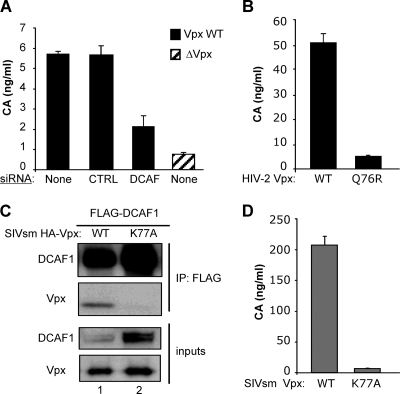FIG. 4.
The recruitment of DCAF1 by incoming Vpx is critical for efficient macrophage transduction by HIV-2. (A) VSV-G-pseudotyped HIV-2 strains were produced by cotransfection of 293T cells with Env-defective proviral DNA and a plasmid encoding the VSV-G envelope. Macrophages were mock treated or transfected with either DCAF1-specific or control (CTRL) siRNA 72 h prior to transduction with the indicated HIV-2 particles. The intracellular CA content was measured by ELISA 72 h postinfection. Shown is a representative experiment out of four performed with macrophages from different donors. The bars represent mean values calculated from triplicate cell lysates, and the corresponding standard deviations are indicated. (B) The VSV-G-pseudotyped HIV-2 particles were produced as for panel A using a Vpx-defective proviral DNA, along with a construct expressing the indicated HIV-2 Vpx proteins. The content in intracellular CA was measured 96 h posttransduction. (C) Vpx WT and Vpx K77A from SIVsmPBj were expressed as HA-tagged proteins and compared for their abilities to interact with FLAG-DCAF1 using coimmunoprecipitation as described in the legend to Fig. 1B. (D) Macrophages were transduced with VSV-G-pseudotyped HIV-2 particles complemented with the indicated SIVsmPbj Vpx proteins, and the content in intracellular CA was measured as for panel B. Similar results were obtained using macrophages from four different donors.

